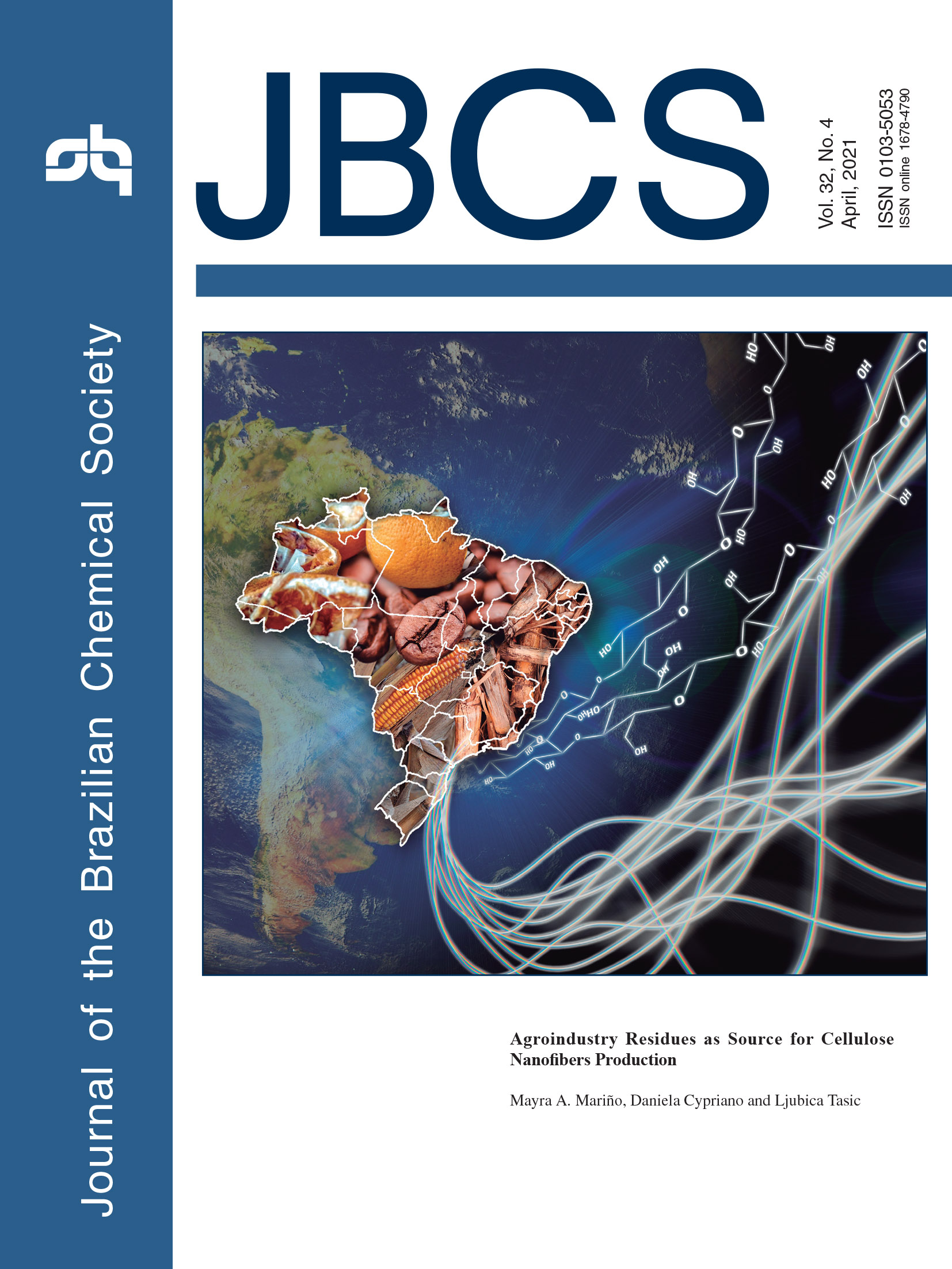vol. 32, No. 4, 2021, p. 695-916
Four Brazilian crop waste biomass: orange bagasse, corn husks, sugarcane straw, and coffee residues were used for cellulose nanofibers (CNF) production. Under moderate conditions, CNFs with diameters in the range 50-70 nm, with high crystallinity indexes, and good yields were obtained. CNF morphologies varied according to the raw material. Finally, the process may add new value to agro-industrial waste and bring great economical valorization to crops production. Details are presented in the Article Agroindustry Residues as Source for Cellulose Nanofibers Production by Mayra A. Mariño, Daniela Cypriano and Ljubica Tasic on page 878.
Agroindustry Residues as a Source for Cellulose Nanofibers Production
Mayra A. Mariño; Daniela Cypriano; Ljubica Tasic
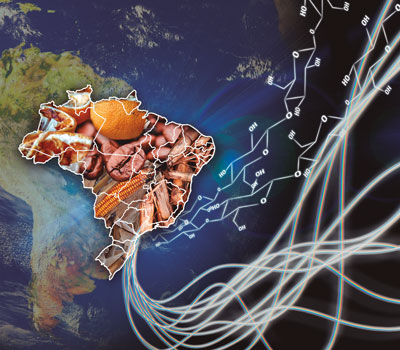
Four Brazilian crop waste biomass: orange bagasse, corn husks, sugarcane straw, and coffee residues were used for cellulose nanofibers (CNF) production. Under moderate conditions, CNFs with diameters in the range 50-70 nm, with high crystallinity indexes, and good yields were obtained. CNF morphologies varied according to the raw material. Finally, the process may add new value to agro-industrial waste and bring great economical valorization to crops production. Details are presented in the Article Agroindustry Residues as Source for Cellulose Nanofibers Production by Mayra A. Mariño, Daniela Cypriano and Ljubica Tasic on page 878.
https://dx.doi.org/10.21577/0103-5053.20200239
Articles J. Braz. Chem. Soc. 2021, 32(4), 695-701
Structural Study of Wheat Gliadin in Different Solvents by Spectroscopic Techniques
Andresa C. Ribeiro; Daiani C. Leite; Jóice M. Scheibel; Rosane M. D. Soares; Nádya P. Silveira

Physicochemical properties of gliadin (one of gluten proteins) has been investigated in three solvents and pH (9.8, 6.8, and 1.2) by dynamic light scattering (DLS), zeta potential (ZP), and attenuated total reflectance Fourier transform infrared spectroscopy (ATR-FTIR).
https://dx.doi.org/10.21577/0103-5053.20200221
J. Braz. Chem. Soc. 2021, 32(4), 702-711
Microwave-Assisted Acid Digestion: Evaluation of Reaction Vessel Design and Performance
Julia A. Garitta; Lucimar L. Fialho; Glenda S. de Oliveira; Roberta M. Maria  ; Camillo Pirola; Antônio G. Ferreira;
; Camillo Pirola; Antônio G. Ferreira;
Joaquim A. Nóbrega
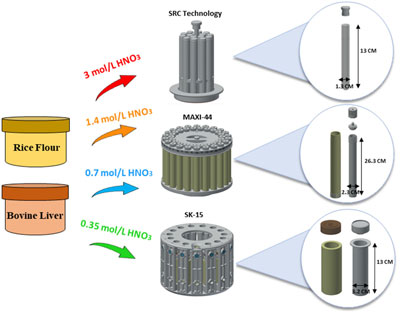
Vegetable and animal tissues were digested using microwave-assisted digestion with diluted nitric acid solutions. Different rotors and vessels were tested: the single reaction chamber (SRC) technology, MAXI 44 and SK-15. It was demonstrated that different configurations of vessels critically influence digestion performance despite using the same heating program.
https://dx.doi.org/10.21577/0103-5053.20200222
J. Braz. Chem. Soc. 2021, 32(4), 712-721
Synthesis, in silico Study and Antileishmanial Evaluation of New Selenides Derived from 7-Chloro-quinoline and N-Phenylacetamides
Min-Fu N. Huang; José A. S. Luis  ; Alison P. da Silva; Juliana C. Rocha; Tatjana K. S. Lima; Marcus T. Scotti
; Alison P. da Silva; Juliana C. Rocha; Tatjana K. S. Lima; Marcus T. Scotti  ; Luciana Scotti; Rafael F. de Oliveira
; Luciana Scotti; Rafael F. de Oliveira  ; Helivaldo D. S. Souza
; Helivaldo D. S. Souza  ; Petrônio F. de Athayde-Filho; José M. Barbosa-Filho
; Petrônio F. de Athayde-Filho; José M. Barbosa-Filho

Virtual screening of selenides, synthesis of the selected compounds and in vitro tests against Leishmania amazonensis, showing their potential as new anti-leishmanial drugs.
https://dx.doi.org/10.21577/0103-5053.20200223
J. Braz. Chem. Soc. 2021, 32(4), 722-731
Validation of an UHPLC-MS/MS Method for the Determination of Malachite Green, Leucomalachite Green, Crystal Violet, and Leucocrystal Violet in Shrimp, Fish, and Salmon Muscle Using a Modified QuEChERS Approach
Diego G. Rocha; Leonardo F. de Souza; Mary Ane G. Lana; Thaís M. L. da Silva; Débora C. S. de Assis
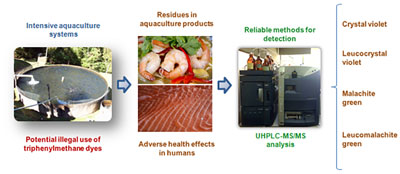
The presence of triphenylmethane dyes and its residues in aquaculture products is of great concern for human health. Thus, an ultra-high performance liquid chromatography tandem mass spectrometry (UHPLC-MS/MS) method to monitor them was validated.
https://dx.doi.org/10.21577/0103-5053.20200224
J. Braz. Chem. Soc. 2021, 32(4), 732-740
Study of the CuII Affinity by Three Chelating Agents of Biological Interest: TPEN, TRIEN and Et2DTC
Eliana M. A. Valle  ; Vinicius G. Maltarollo; Thiago C. Princhak; Kathia M. Honorio; Giselle Cerchiaro
; Vinicius G. Maltarollo; Thiago C. Princhak; Kathia M. Honorio; Giselle Cerchiaro
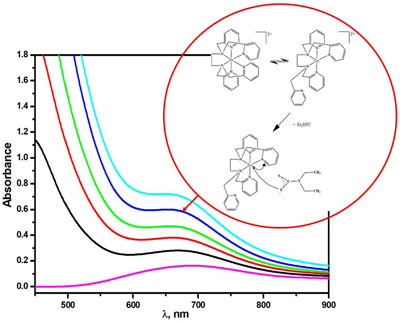
Copper (II) showed higher affinity by diethyldithiocarbamate (Et2DTC) ligand than by N,N,N,N'-tetrakis (2-pyridilmethyl) ethylenediamine (TPEN) and triethylenetetramine (TRIEN) ligands, following the order Et2DTC > TPEN > TRIEN. The energy for the interaction of the species is shown for the first time and coincide with the experimental data. In the spectrum shown, the TPEN ligand is replaced by the Et2DTC ligand, with the scheme proposed in this work.
https://dx.doi.org/10.21577/0103-5053.20200225
J. Braz. Chem. Soc. 2021, 32(4), 741-756
The Stabilization of Asphaltenes in Different Crude Fractions: A Molecular Approach
Faissen B. Lordeiro; Rodrigo Altoé; Daniela Hartmann; Eduardo J. M. Filipe; Gaspar González; Elizabete F. Lucas
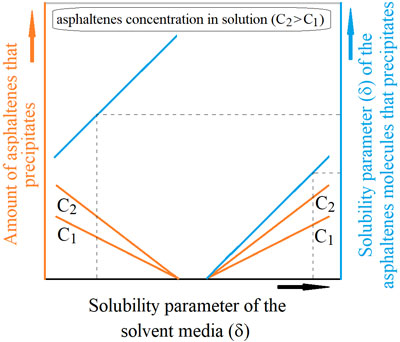
Correlation among solubility parameter (δ) of the solvent media, δ of the asphaltenes molecules that precipitates and amount of asphaltenes that precipitates.
https://dx.doi.org/10.21577/0103-5053.20200226
J. Braz. Chem. Soc. 2021, 32(4), 757-766
Synthetic Studies toward (−)-Cleistenolide: Highly Stereoselective Synthesis of New γ-Lactone Subunits
Suélen K. Sartori; Izabel L. Miranda; Davi A. de Matos; Markus Kohlhoff; Marisa A. N. Diaz; Gaspar Diaz-Muñoz
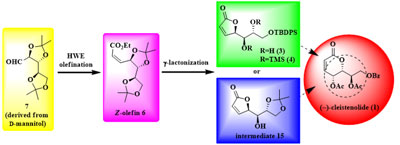
This study describes the stereoselective synthesis of two new γ-lactones, 3 and 15, in 6 and 3 steps and 19 and 32% yield, respectively, directed toward the total synthesis of the natural product (−)-cleistenolide.
https://dx.doi.org/10.21577/0103-5053.20200227
J. Braz. Chem. Soc. 2021, 32(4), 767-776
Identification of Potential Human Protein Targets for Soybean Isoflavones
Wilson Maldonado-Rojas  ; Juan Salinas-Torres; Jesús Olivero‑Verbel
; Juan Salinas-Torres; Jesús Olivero‑Verbel
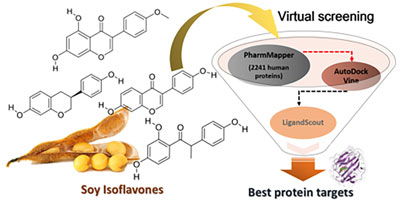
Virtual screening was employed to identify potential human target proteins for soybean isoflavones in order to elucidate alternative biological mechanisms that explain some effects of these chemicals.
https://dx.doi.org/10.21577/0103-5053.20200228
J. Braz. Chem. Soc. 2021, 32(4), 777-785
Device for Streptavidin Detection Using LSPR and Electrochemical Transductions on the same Platform
Maria G. V. Fressatti; Bento P. Cabral Jr.; Jean H. de Oliveira; Paulo H. M. Buzzetti  ; Eduardo Radovanovic
; Eduardo Radovanovic  ; Johny P. Monteiro
; Johny P. Monteiro  ; Emerson M. Girotto
; Emerson M. Girotto
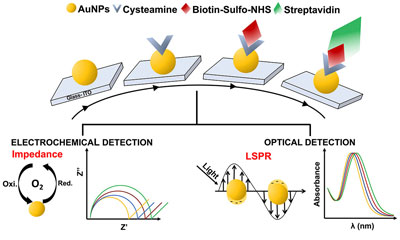
A new device for detecting streptavidin based on dual transduction is shown. Localized surface plasmon resonance and electrochemical impedance spectroscopy techniques were used to evaluate the analyte on the same transducer (gold nanoparticles-coated indium thin oxide (ITO)).
https://dx.doi.org/10.21577/0103-5053.20200229
J. Braz. Chem. Soc. 2021, 32(4), 786-799
Bioactive Bioflavonoids from Platonia insignis (Bacuri) Residues as Added Value Compounds
Dayane C. Ribeiro; Helena M. Russo  ; Karina Fraige
; Karina Fraige  ; Maria L. Zeraik
; Maria L. Zeraik  ; Cláudio R. Nogueira
; Cláudio R. Nogueira  ; Patrícia B. da Silva; Ana C. Codo; Giovana M. F. Calixto; Alexandra I. de Medeiros
; Patrícia B. da Silva; Ana C. Codo; Giovana M. F. Calixto; Alexandra I. de Medeiros  ; Marlus Chorilli
; Marlus Chorilli  ; Vanderlan S. Bolzani
; Vanderlan S. Bolzani
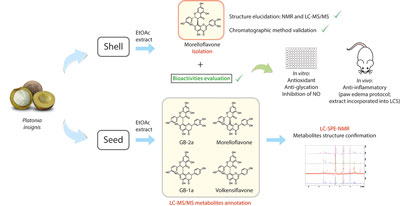
Bioflavonoids from Platonia insignis fruit residues (seeds and shell) were identified. The ethyl acetate shell extract showed important in vitro and in vivo bioactivities, besides the selective extraction of the biflavonoid morelloflavone.
https://dx.doi.org/10.21577/0103-5053.20200230
J. Braz. Chem. Soc. 2021, 32(4), 800-810
In silico Evaluation of Cucurbit[6]uril as a Potential Detector for Cocaine and Its Adulterants Lidocaine, Caffeine, and Procaine
Caio H. P. Rodrigues ; Jorge E. Hernández-González
; Jorge E. Hernández-González ; Natalia J. Pedrina; Vitor B. P. Leite
; Natalia J. Pedrina; Vitor B. P. Leite ; Aline T. Bruni
; Aline T. Bruni
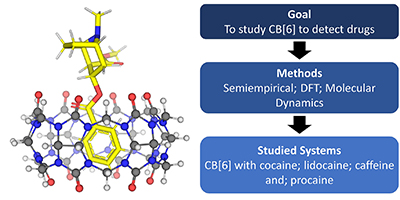
This article aims to analyze the interaction between cucurbit[6]uril with cocaine and adulterants through different computational methodologies for forensic purposes.
https://dx.doi.org/10.21577/0103-5053.20200231
J. Braz. Chem. Soc. 2021, 32(4), 811-822
Thermal and Catalytic Fast Pyrolysis of Oily Extracts of Microalgae: Production of Biokerosene
Noyala S. C. Fonseca; Victor C. Oliveira; Roger Fréty  ; Emerson A. Sales
; Emerson A. Sales
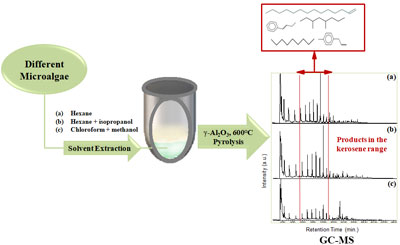
Fractions of three different microalgae biomasses were extracted using three solvents (n-hexane, n-hexane + isopropanol, methanol + chloroform). Each extract was pyrolyzed under inert atmosphere at 600 ºC, in presence of transition alumina. The products were analyzed by gas chromatography-mass spectrometry (GC-MS). Pyrograms obtained show deoxygenated molecules in the kerosene range.
https://dx.doi.org/10.21577/0103-5053.20200232
J. Braz. Chem. Soc. 2021, 32(4), 823-832
Development and Validation of a Gas Chromatographic Method for the Quantification of Minor Alkaloids in Cocaine
Adriano O. Maldaner  ; Jorge J. Zacca; Élvio D. Botelho; Dina R. Silva; Fillipe H. Oliveira
; Jorge J. Zacca; Élvio D. Botelho; Dina R. Silva; Fillipe H. Oliveira

A fully validated gas chromatographic method for the quantification of minor alkaloids in cocaine provides a tool to strength forensic chemistry and law enforcement reports, providing meaningful scientific based information to the Justice system.
https://dx.doi.org/10.21577/0103-5053.20200233
J. Braz. Chem. Soc. 2021, 32(4), 833-841
Reduced Graphene Oxide-Cadmium Sulfide Quantum Dots Nanocomposite Based Dispersive Solid Phase Microextraction for Ultra-Trace Determination of Carbamazepine and Phenobarbital
Ali Shafiee  ; Behzad Aibaghi
; Behzad Aibaghi  ; Xu Zhang
; Xu Zhang
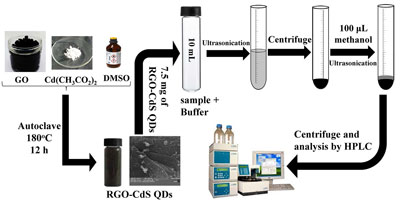
Reduced graphene oxide sheet decorated with tiny cadmium sulfide quantum dots was synthesized and used as a high capacity adsorbent for adsorption and preconcentration of the analytes.
https://dx.doi.org/10.21577/0103-5053.20200234
J. Braz. Chem. Soc. 2021, 32(4), 842-851
Alternative Approaches Applied to Inductively Coupled Plasma Techniques: Multi‑Flow and Two-Flow Calibration
Raquel C. Machado  ; Ana Beatriz S. Silva
; Ana Beatriz S. Silva  ; Daniel F. Andrade; Fernanda C. Pinheiro; Charles B. Williams; George L. Donati
; Daniel F. Andrade; Fernanda C. Pinheiro; Charles B. Williams; George L. Donati  ; Ana Rita A. Nogueira
; Ana Rita A. Nogueira  ; Edenir R. Pereira‑Filho
; Edenir R. Pereira‑Filho
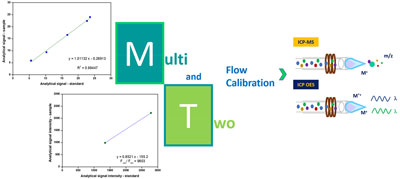
Multi-flow calibration and two-flow calibration are non-traditional calibration strategies based on the obtaining of the analytical signals at different nebulization gas flow rates and applied for the first time in argon plasma-based techniques.
https://dx.doi.org/10.21577/0103-5053.20200235
J. Braz. Chem. Soc. 2021, 32(4), 852-859
[5]Helicene-Scaffold Fluorescence Sensing for Selective Detection of Au3+ Ions and Gold Nanoparticle
Pichayanun Sinthuprasert; Anuwut Petdum; Pattanawit Swanglap; Waraporn Panchan; Thanasat Sooksimuang; Nantanit Wanichacheva  ; Krit Setthakarn
; Krit Setthakarn
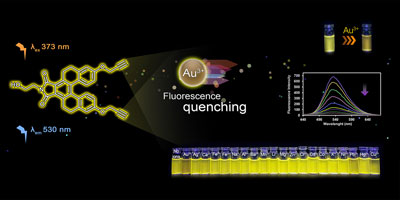
A new [5]helicene-based fluorescence sensor exhibited good ability to determine Au3+ in aqueous solution and real samples.
https://dx.doi.org/10.21577/0103-5053.20200236
J. Braz. Chem. Soc. 2021, 32(4), 860-868
Improving Photoluminescence Quantum Yield of CdTe Quantum Dots Using a Binary Solvent (Water + Glycerin) in the One-Pot Approach Synthesis
Lucas T. A. da Rosa; Isabella F. S. Aversa; Ellen Raphael; André S. Polo  ; Alfredo Duarte
; Alfredo Duarte  ; Marco A. Schiavon
; Marco A. Schiavon  ; Luciano S. Virtuoso
; Luciano S. Virtuoso
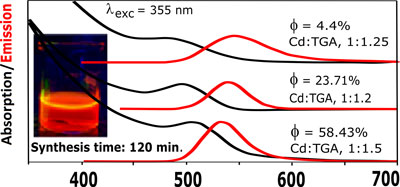
The comparison between CdTe quantum dots (QD) synthesized in water and in the binary solvent (water + glycerin) via one-pot approach was studied. By using the binary solvent and the molar ratio 1:1.5 of Cd:TGA (thioglycolic acid), a narrow photoluminescence band and significantly enhanced photoluminescence quantum yield (ɸ𝑓) was observed.
https://dx.doi.org/10.21577/0103-5053.20200237
J. Braz. Chem. Soc. 2021, 32(4), 869-877
First-Principles Calculations of a New Semi-Conductive Carbon Allotrope Named ABF-Carbon
Felipe L. Oliveira  ; Pierre M. Esteves
; Pierre M. Esteves
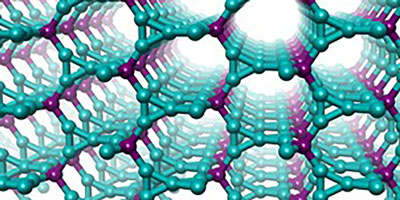
By combining the spiropentadiene structural motif and carbon atoms with sp3 hybridization we propose the existence of a new carbon allotrope, called ABF-Carbon.
https://dx.doi.org/10.21577/0103-5053.20200238
J. Braz. Chem. Soc. 2021, 32(4), 878-888
Agroindustry Residues as a Source for Cellulose Nanofibers Production
Mayra A. Mariño; Daniela Cypriano; Ljubica Tasic
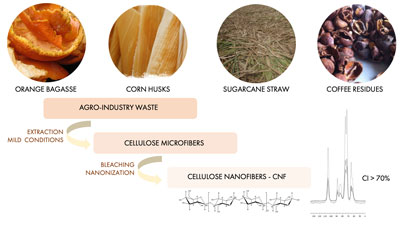
Four tropical climate agro-industrial wastes were converted into cellulose nanofibers (CNF) exploring a moderate temperature and pressure chemical process.
https://dx.doi.org/10.21577/0103-5053.20200239
J. Braz. Chem. Soc. 2021, 32(4), 889-899
Voltammetric Generation and Kinetic Stability of Nitro Anion Radical from Nitrofurazone in Ionic Liquids
Luisa D. Chiavassa; Fernanda F. Camilo; Mauro A. La Scalea

The nitro group reduction mechanism from nitrofurazone and its nitro radical formation, besides stability and kinetics parameters, were determined in ionic liquids by electrochemical techniques.
https://dx.doi.org/10.21577/0103-5053.20200240
J. Braz. Chem. Soc. 2021, 32(4), 900-911
Efficient Synthesis and Antimicrobial Activities of Long Alkyl Chain Trifluoromethyl-1H-pyrazol-1-(thio)carboxamides and Trifluoromethyl-1H-pyrazol-1-yl-thiazoles
Debora L. de Mello; Juliana L. Malavolta; Roberto C. V. Santos  ; Leonardo Q. S. Lopes; Sidnei Moura; Darlene C. Flores
; Leonardo Q. S. Lopes; Sidnei Moura; Darlene C. Flores  ; Alex F. C. Flores
; Alex F. C. Flores
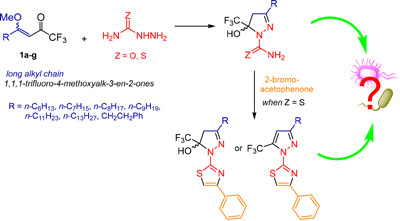
Fourteen new 3-alkyl-5-trifluoromethyl-1H-pyrazol-1-(thio)carboxamides and fourteen 2-(3-alkyl-5-trifluoromethyl-1H-pyrazol-1-yl)-thiazoles derivatives were planned and synthesized. The new compounds were obtained through the cyclization reactions, and were evaluated in vitro for antimicrobial activity.
https://dx.doi.org/10.21577/0103-5053.20200241
J. Braz. Chem. Soc. 2021, 32(4), 912-916
Synthesis of a Homologous Series of Trialkyl Arsines (C3-C12) and Applications of Arsenic Triiodide as a Synthetic Precursor
Carolina B. P. Ligiéro  ; Marcos A. S. Francisco; Michelle S. Gama; Carlos A. Carbonezi; Isabela C. L. Leocadio; Wladmir F. de Souza; Pierre M. Esteves
; Marcos A. S. Francisco; Michelle S. Gama; Carlos A. Carbonezi; Isabela C. L. Leocadio; Wladmir F. de Souza; Pierre M. Esteves
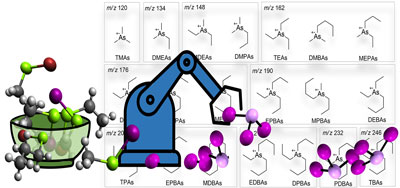
After some post-synthetic improvements, the use of arsenic triiodide as an air-stable precursor for the preparation of some AsIII compounds is presented. A homologous series of trialkylarsines from As(Me)3 to As(Bu)3 was obtained and analyzed with two-dimensional chromatography coupled with time of flight mass spectrometry (GC x GC-TOFMS).
https://dx.doi.org/10.21577/0103-5053.20200242
Online version ISSN 1678-4790 Printed version ISSN 0103-5053
Journal of the Brazilian Chemical Society
JBCS Editorial and Publishing Office
University of Campinas - UNICAMP
13083-970 Campinas-SP, Brazil
Free access










